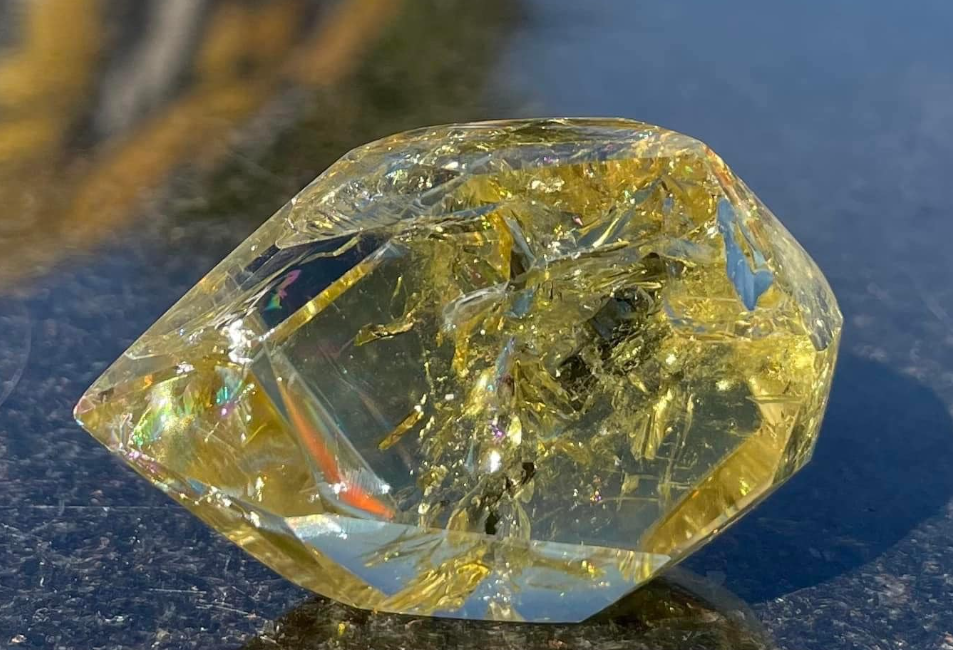
The Science and Formation of Citrine
Share
Citrine is a striking variety of quartz, admired for its warm golden hues and durability. While historically associated with prosperity and creativity, its geological origins reveal a complex interplay of mineral transformations, heat exposure, and environmental conditions. Naturally occurring citrine is relatively rare, making it a valuable subject for mineralogical study.
Geological Formation and Occurrence
Citrine forms through the thermal alteration of iron-bearing quartz, primarily amethyst or smoky quartz. This transformation occurs under various geological conditions, reshaping the crystal’s internal structure and oxidation state to develop its characteristic colouration. The three main processes responsible for citrine formation are:
-
Hydrothermal veins – In regions with high geothermal activity, mineral-rich fluids circulate through fractures in rock formations. As quartz crystals grow within these veins, exposure to heat and chemical interactions modify iron impurities, shifting them into a ferric oxidation state. This alteration is key to citrine’s golden hue.
-
Volcanic activity – Quartz deposits near volcanic regions can experience direct exposure to extreme heat from magma chambers or geothermal vents. This thermal environment induces oxidation, causing iron atoms within the quartz lattice to transition into a colour-producing state.
-
Sedimentary processes – Over millions of years, chemical reactions in surface environments influence mineral development. Weathering and interactions with mineral-rich groundwater can gradually modify quartz structures, leading to citrine’s yellow hues through prolonged exposure to trace elements.
While natural citrine is found worldwide, it is particularly concentrated in regions rich in hydrothermal and volcanic activity. Some of the most significant sources of naturally occurring citrine include Brazil, Madagascar, and Zambia, where extensive deposits are mined from hydrothermal veins and alluvial formations. However, due to its rarity, most commercial citrine is produced by artificially heat-treating amethyst or smoky quartz, replicating the natural geological transformation.
Physical and Chemical Properties
Citrine retains all the fundamental characteristics of quartz but possesses distinct colouration due to iron oxidation. Its structural and chemical properties make it both scientifically and commercially valuable:
-
Chemical formula – Silicon dioxide (SiO₂), with trace iron content responsible for its colour.
-
Crystal system – Trigonal, forming elongated hexagonal prisms with a vitreous lustre.
-
Hardness – 7 on the Mohs scale, ensuring resistance to scratching and wear, making it suitable for jewellery and industrial applications.
-
Fracture pattern – Conchoidal, meaning it breaks with curved, shell-like edges characteristic of quartz minerals.
-
Transparency – Ranges from transparent to translucent, depending on trace element content and structural variations.
Due to its structural integrity and aesthetic appeal, citrine is widely sought after in gemstone markets and scientific research.
Uses and Applications
Citrine has been admired throughout history, not only for its brilliance but also for its durability and metaphysical associations.
-
Jewellery and ornamental carvings – Valued for its vibrant golden hues, citrine remains a popular gemstone for rings, pendants, and decorative pieces. Its ability to hold a fine polish enhances its appeal.
-
Industrial applications – Quartz, including citrine, is widely used in electronics, optical lenses, and precision instruments due to its piezoelectric properties, which allow it to convert mechanical energy into electrical signals.
-
Geological significance – Studying citrine’s formation provides insight into mineral transformations, heat-induced colour shifts, and oxidation processes within Earth’s crust. Understanding its crystallisation helps geologists interpret broader mineralogical patterns in quartz-rich environments.
-
Metaphysical associations – Citrine has long been believed to symbolise prosperity and emotional clarity, although these claims lack scientific verification.
Citrine in Geological Research
Citrine is valuable for mineralogists and geologists studying crystallisation processes, fluid movement within Earth's crust, and iron oxidation in quartz minerals. By examining naturally occurring citrine, researchers refine their understanding of geological heat transformations and crystallisation conditions. Furthermore, distinguishing genuine citrine from heat-treated specimens aids in gemstone classification and market valuation.
Shop Citrine Online or Join Our Facebook Wholesale Group
References
-
Geological formation and occurrence: geologyscience.com
-
Physical and chemical properties: geologyin.com
-
Uses and historical significance: aovcrystals.com